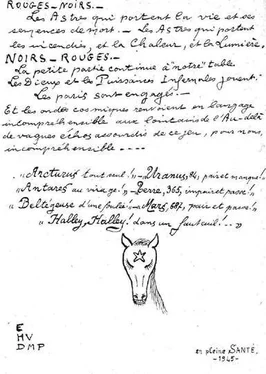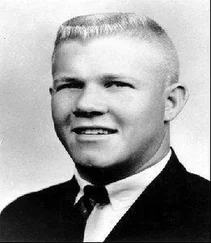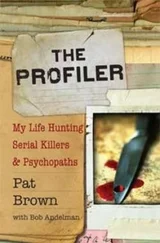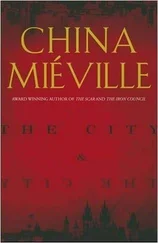The court essentially retraced an alleged victim’s path. The triangular room was too small for everyone to fit in at once, and so they broke up into groups. When Leser, Dupin, Floriot, Sannié, Petiot, and a couple of jurors entered, the candle went out, and no one had a match to relight it. After an uncomfortable moment in the dark, a policeman finally arrived with a flashlight. One thing, however, was missing: the Lumvisor viewer that Petiot allegedly used to spy on his victims.
“Where is the viewer?” Floriot asked.
“I don’t know,” Sannié said.
“This is unbelievable,” Floriot said, criticizing the prosecution for its handling of evidence under official seal.
“I would have preferred that the viewer had been here,” Petiot said, because he wanted to explain its function. Turning to a specific juror, who seemed frightened at being addressed, Petiot offered to describe the lens. It was not a periscope, he said, but “a sort of telescope” that allowed him to see a certain part of the room from the outside: “Precisely where Monsieur le Président is now standing.” The device would help him monitor his radiotherapy equipment, which he had planned to install in the room.
One of the jurors asked, if Petiot intended to use this viewer for medical purposes, why he covered the lens with wallpaper? Petiot explained that he had wanted to wallpaper the room but one of the workers had covered the lens by mistake. Another juror wondered if this small room could be used as a cell.
Petiot denied that with sarcasm, saying that it was impossible to detain anyone in here, let alone kill them in “this little hole.” He turned to Président Leser: “Would you tell me how you would go about killing someone here?”
A member of the jury pointed out that a murder can take place in smaller places, like the truck Petiot claimed that his Fly-Tox organization used.
“Oh, obviously you can kill anywhere,” Petiot said, losing his temper. He had admitted executing people, so what difference did it make where he killed them? “Stories like this are going to make us look like idiots to the rest of the world.”
Yet the walls were thick enough to drown out any cries for help, it had been noted. Petiot explained the thick, soundproof walls as a protection against the radiation of his X-ray machines—he could not use lead, of course, as it was a very difficult substance to obtain during the war. No one asked why he did not wait for better materials, as he claimed he was not going to use the clinic anyway until after the war.
At times, during the visit, Petiot looked pale. Once or twice, losing his balance, he was forced to grab on to a nearby rail or on to Floriot’s arm. After exiting into the courtyard and into the garage, Petiot again nearly stumbled. This time, he was standing at the edge of the lime pit. Several journalists witnessing the scene reported that Petiot had finally come to grips with the sheer magnitude of his crimes. Another one believed that he was mocking the tragedy.
It is more likely, however, that Petiot was suffering giddiness from a poor diet. As the Swiss journalist Edmond Dubois discovered, the defendant had barely eaten all day, or indeed the last five days, since the trial began. He had been picked up at prison before breakfast and returned to his cell after dinner. He had been subsisting on little more than a small bowl of soup and a slice of bread.
At this point, it was time to enter the basement. Professor Sannié continued explaining, like a tour guide, what they had found, pointing out its location and describing its state. “It is here at the bottom of these steps that I discovered pieces of cadavers,” he said. “Next to the two furnaces you see there was half a human body, split in the middle. In the larger furnace were human remains burning and sizzling with human juices and blood oozing out from the heat.”
Sannié also mentioned the bag, outside the landing, that contained “half a corpse.”
Petiot interrupted, asking the expert to confirm that it was a German army mail sack.
Sannié thought it was a cement bag.
“This sack is under seal, isn’t it?” Floriot asked.
Sannié did not answer.
“This is truly incredible.”
There were certainly risks in moving the courtroom to this location, and many irregularities emerged, any one of which could cause a mistrial. In addition to the growing list of missing or misplaced evidence, the door to Petiot’s town house had remained open; when someone tried to close it, Leser refused. It was a public trial, he said, not wanting to open a loophole for the defense. Yet, because he had insisted on the openness, the crowds eventually managed to swarm past the roped barriers and the police officers. Robert Cusin of L’Aurore compared the rush of spectators to a rugby scrum.
Several members of the public roamed the building virtually at will. “Do you want to see the boiler?” an elderly couple was overheard asking their granddaughter. A reporter was inspecting the stove closely enough with his flashlight to spot the hairs scorched into the grate. Another journalist witnessed members of the public urinating in a corner.
Souvenirs were snatched, like an ashtray from Petiot’s office, medical brochures, and review journals, some of them with the physician’s notes in the margins. Someone walked away with Petiot’s copy of Céline’s Bagatelles pour un massacre; another person with an early edition of Pascal. One man was seen rushing out of the building carrying a stack of Petiot’s criminal novels and treatises. More disturbingly, papers were flung out of office windows. Leser’s son was said to have uncovered a tibia. Prosecution lawyers were even photographed that day holding what one astonished reporter identified as “human shin bones in their hands.” Some of the many alleged bones were likely chunks of quicklime left over from the retrieval of the remains from the pit.
Just after four o’clock that afternoon, as the expedition wound its way back to the front of the building, certain members of the audience started shouting, “Death to the assassin!” As for the jurors, the trip to 21 rue Le Sueur had not delivered the wave of sympathy that Floriot and Petiot had hoped. The so-called future clinic of the doctor had not seemed innocent, but rather more grim and horrific than ever.
30.
BLACK FINGERNAILS
THESE INJECTIONS, PETIOT SAID, WOULD RENDER US INVISIBLE TO THE EYES OF THE WORLD.
—Michel Cadoret de l’Epinguen
PROFESSOR Sannié took the stand again in the short late-afternoon session at the Palais de Justice. Maître Jacques Bernays, the civil attorney representing the Wolff family, asked him about Petiot’s statement that he had planned to put medical machinery in the triangular room. “It is absurd and ridiculous,” Sannié answered. He could not squeeze an examination table into the small room, let alone bulky machinery.
Petiot protested that, while the room was small and he had used it to question traitors captured by his group, it had not served as a torture chamber. Nothing he said, however, addressed Sannié’s point that medical equipment for his so-called clinic simply would not fit into the room. Floriot came to his client’s assistance, reminding the court that there was no evidence whatsoever to support the hypothesis that the triangular room was a torture chamber or prison cell. There was not even a sign of a struggle or any attempt to escape its confines, as surely would be the case if the room had been used as the prosecution claimed.
“Did you find any of Petiot’s fingerprints on any of the objects taken from rue Le Sueur?” Floriot asked.
“No, we did not find any of his fingerprints.”
Читать дальше












